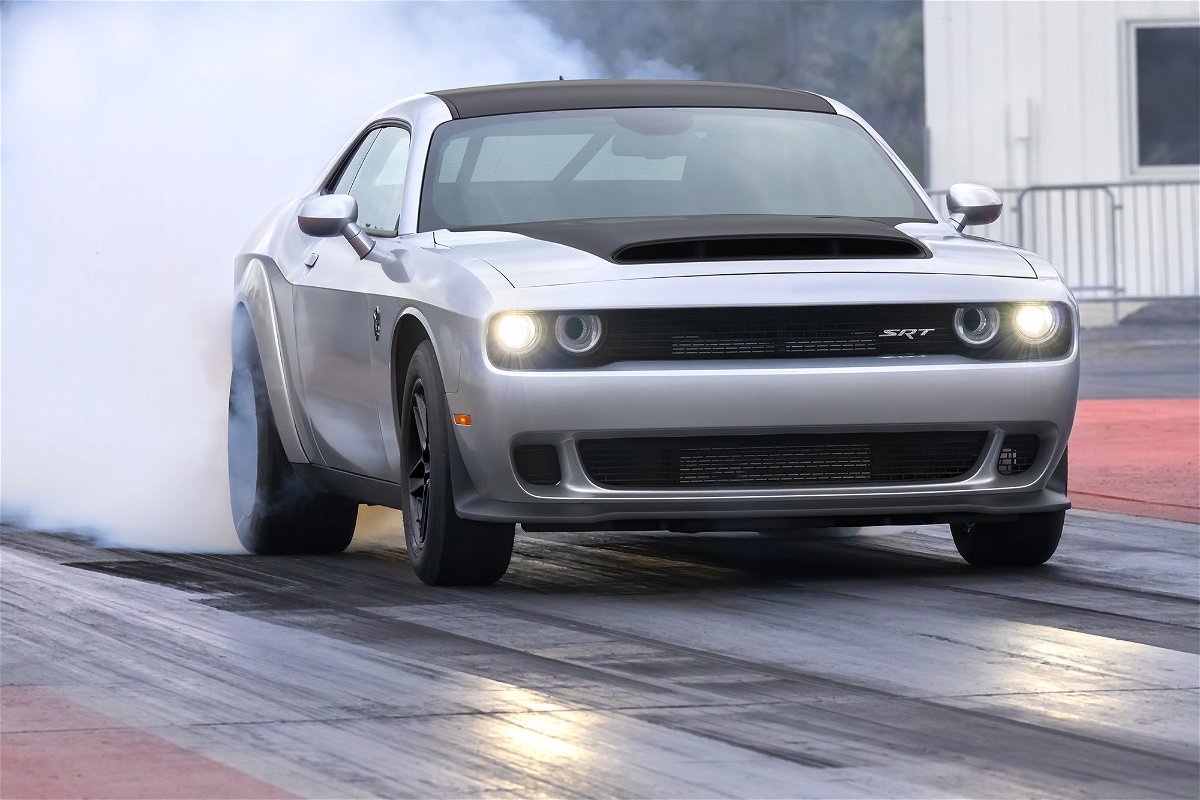Last Dodge Challenger makes 1,025 hp, has optional parachute attachments

Dodge Challenger SRT Demon 170 can run a quarter mile in about 8.9 seconds.
By Peter Valdes-Dapena, CNN
With Dodge’s legendary V8-powered muscle cars going out of production at year-end, engineers wanted the last non-electric Dodge Challenger to make a statement. Sort of a very fast, very loud, statement: A final salute to the fuel-burning era. Buyers just might want to attach a parachute.
The Demon 170 will be able to go from zero to 60 miles an hour in just under 1.7 seconds under ideal circumstances, according to Dodge. (Ideal circumstances would include a professional driver and a properly prepared drag strip.) A possible add-on is a parachute mounting system — parachute not included — to aid in drag-strip stops. It will be sold separately under Dodge’s Direct Connection-brand, and is designed to bolt onto the back of the car.
The unveiling of the 1,025 horsepower Dodge Challenger SRT Demon 170 has been long anticipated, and long delayed. Engineers kept blowing up engines during development testing, said Tim Kuniskis, chief executive of Stellantis’s Dodge brand. To deal with this engine’s “massive, massive cylinder pressures” a lot of work had “to be done to make sure that the inside parts stay inside and not outside,” he said.
To produce this much power, the engine relies on a supercharger, a mechanical air pump that forces air into the engine allowing more fuel to be burned and more power to be produced. The supercharger used on this car produces much higher pressures than the ones used on the already-powerful Dodge Hellcat SRT Demon model.
The result is a vehicle quicker than some high-performance all-wheel-drive electric cars like the Pininfarina Battista and the Tesla Model S Plaid.
The Demon 170 is not electric, though, and it’s also rear-wheel-drive only, with an eight-speed transmission. (An all-wheel-drive electric car, with better traction and a single-speed transmission, could require less specialized conditions and less highly skilled driving to achieve its quickest zero-to-60 time.)
There are trade-offs for the Demon’s performance, though. Kuniskis described the car’s fuel economy as “terrible,” without giving any specific numbers. He did say that, at full throttle, the car could completely drain its tank of racing fuel in about five minutes and 45 seconds. That figure is largely theoretical, since it would be hard to find anywhere to drive the car at full throttle for that long.
The Demon 170 will produce its maximum horsepower using racing fuel, called E85, that’s up to 85% alcohol. That’s where the number 170 in the car’s name comes from. If E85 were liquor it would be “170 proof” — a liquor’s proof number is double its alcohol percentage. (Drinking racing fuel is not recommended and can be fatal.) With the more ordinary sort of fuel you can get from a street-side gas station, which is mostly gasoline, the Demon 170 can produce up to 900 horsepower, according to Dodge.
“This is a serious car. This is a race car,” said Kuniskis. “You know, it’s not going to be a smooth-riding drive-it-to-church car.” Buyers will need to sign a notarized disclaimer stating that they understand this is not a normal car intended for everyday driving.
It’s the last of a series of so-called Last Call special edition Dodge Challenger and four-door Dodge Charger models that Stellantis is producing to mark the end of these V8-powered models. Both cars will go out of production at the end of this year.
Prices for the Demon 170 will start at $96,666, not including an expected gas guzzler tax that could be as much as $7,700. Dodge dealers are also selling a convertible version of the Challenger during this, its last model year.
Dodge had originally expected to just modify the Dodge Challenger Demon engine, which is capable of producing up to 840 horsepower. But those repeated, and sometimes spectacular, failures during testing, proved that substantial changes were needed to achieve a four-figure power output goal. Lots of things needed to be made stronger and, ultimately, the Demon 170 ended up sharing very few mechanical parts with the original Demon.
Introduced in 2008, the modern Dodge Challenger shares much of its engineering with the four-door Dodge Charger and Chrysler 300 sedans. (Those models are also going out of production.) The two-door Challenger, though, is closely modeled on earlier Dodge Challengers from the classic muscle car era of the early 1970s.
While it’s often thought of as a competitor to the Ford Mustang and Chevrolet Camaro, the Challenger is a bigger, heavier car and Kuniskis admits it doesn’t corner and handle as well as those smaller models. Its performance appeal is raw straight-line speed and power, or — for customers who buy cheaper V6-powered Challengers — at least the appearance of it.
The Demon 170 does not have the wide fender flares of the original Demon, nor does it come with a set of ultra-narrow front tires — called front-runners — for drag racing. That’s because this new car’s suspension has been changed so that, during hard drag-strip starts, its front doesn’t as easily rise up, shifting weight to the back tires.
The Demon was famous for being able to relatively easily “pop a wheelie,” with its front wheels entirely leaving the ground during very aggressive starts. In the Demon 170, the front rises more gradually. Since less energy is wasted lifting the car’s nose, more can be used moving the car straight down the track, said Kuniskis.
The Demon 170 is offered with optional ultra-light wheels. The centers of the wheels are made from aluminum, while the outer rims are made from carbon fiber. There’s no need to change the wheels or tires before running it on a drag strip, Kuniskis said, unlike the original Challenger Demon. Of course, that means, while the tires are perfectly legal for street use, they might not be ideal for all driving conditions.
“Do not drive them in the cold, do not drive them in the rain, do not drive them in any moisture — but yes, they are street legal,” said Kuniskis.
A maximum of 3,300 Demon 170s will be built — 3,000 for the United States and 300 for Canada. But production will have to stop when Stellantis’s Brampton, Ontario, Canada factory, where the Challenger is built, shuts down at the end of this year. If all 3,300 cars haven’t been built by then, said Kuniskis, then that’s it. That’s all there will be.
Dodge is already working on a new, fully electric muscle car that’s expected to be available in 2024.
The-CNN-Wire
™ & © 2023 Cable News Network, Inc., a Warner Bros. Discovery Company. All rights reserved.



